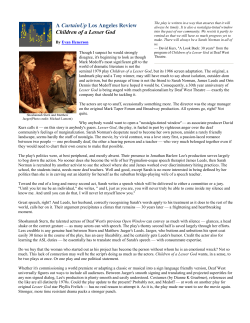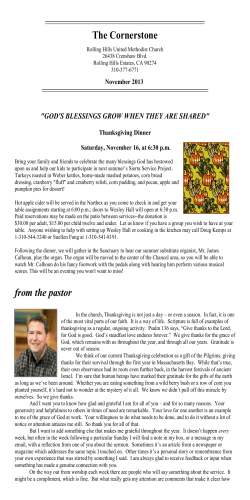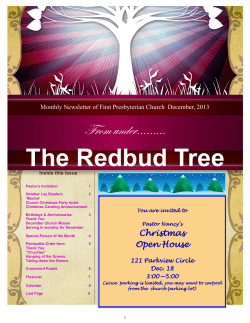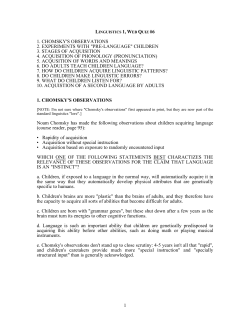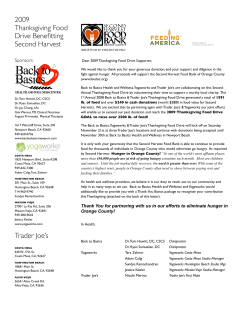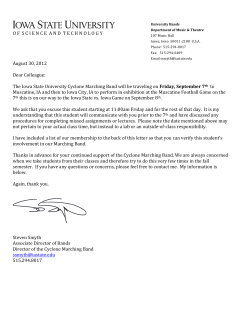
THE GODMOTHER OF THANKSGIVING: the story of
THE GODMOTHER OF THANKSGIVING: the story of Sarah Josepha Hale by Peggy M. Baker, Director & Librarian, Pilgrim Society & Pilgrim Hall Museum 2007 Ever since the days of Priscilla Mullins of the Mayflower, New England has been home to feminine, gracious and inexorable women. One such woman, Sarah Josepha Buell Hale, can be called the “Godmother of Thanksgiving.” Sarah Josepha Buell was born in New Hampshire in 1788. She and her siblings were schooled at home. In her autobiographical foreword in The Ladies‟ Wreath of 1837, she noted that ”I owe my early predilection for literary pursuits to the teaching and example of my mother. She had enjoyed uncommon advantages of education for a female of her times – possessed a mind clear as rock-water, and a most happy talent of communicating knowledge.” A voracious reader of whatever books were available, Sarah noticed that ”of all the books I saw, few were written by Americans, and none by women “ and she was inspired, at a very early age, to “promote the reputation of my own sex, and do something for my own country.” The Ladies Wreath (Boston: Marsh, Capen & Lyon, 1837) was one of a number of "gift books" of uplifting poetry for women that Sarah edited throughout her long career. Sarah’s brother, Horatio Gates Buell, was schooled at home with her. Unlike Sarah, however, Horatio could go to college. He shared his Dartmouth textbooks with his sister, Sarah noting that “he seemed very unwilling that I should be deprived of all his collegiate advantages.” This self-educated young woman began teaching school at age 18. She also began, in her spare time, to write poetry. After six years of independent living, she married David Hale, a lawyer with strong literary interests of his own and an appreciation for his bride’s intelligence. Sarah described their home life ” We commenced, soon after our marriage, a system of study and reading which we pursued while he lived. The hours allowed were from eight o‟clock in the evening till ten; two hours in the twenty-four: how I enjoyed those hours! In all our mental pursuits, it seemed the aim of my husband to enlighten my reason, - strengthen my judgment, and give me confidence in my own powers of mind, which he estimated much higher than I. But this approbation which he bestowed on my talents has been of great encouragement to me in attempting the duties that have since become my portion.” This idyllic life ended after only 9 years. In 1822, David Hale died of a stroke, leaving Sarah with 5 children; the oldest was 7 and the youngest was born two weeks after David’s death. Sarah was 34. David Hale did not leave a large estate. Sarah now had 5 children – 3 sons and 2 daughters - to raise on her own, to educate and prepare for life. How was she to do this? Sarah considered deeply and decided that the “very few employments in which females can engage with any hope of profit, and my own constitution and pursuits, made literature appear my best resource. I prepared a small volume of Poems, mostly written before my husband‟s decease; these were published, by the aid of the Free Masons, of which order he was a distinguished member.” Sarah Josepha Hale's second book of poetry, Poems for Our Children, published in 1830, contained one of the most famous poems in the English language - “Mary Had a Little Lamb.” The poem became even more famous when it was republished in Juvenile Miscellany (an interesting note, the editor of Juvenile Miscellany was Lydia Maria Child, who would later write a famous Thanksgiving poem that began “Over the river and through the woods, to grandfather’s house we go…”) A question that is still debated is: Did Sarah Josepha Hale actually write the poem? It has been claimed that there was a real Mary (Mary Sawyer of Sterling, Massachusetts), who actually had a lamb who followed her to school, etc., and that a young man named John Roulstone wrote the famous beginning verses of the poem, Sarah merely adding extra (and lesser known) verses. Sarah Josepha Hale herself said that the poem was her own composition and was based very roughly on an incident from her own childhood. She also pointed out "the incident of an adopted lamb following a child to school has probably occurred many times." This woodcut, illustrating the story of a blind girl and her pet lamb, is from an 1830's "toy book." Even before Sarah had published her famous poem, however, she had written a novel, Northwood, published in Boston in 1827. Northwood, which was descriptive of New England character and manners, first introduced to the American public what would become one of Sarah’s lifelong obsessions: the promotion of the holiday of Thanksgiving. In Northwood, she gave the first detailed description to be found anywhere of this New England tradition: ”The table, covered with a damask cloth, vieing in whiteness, and nearly equaling in texture, the finest imported, though spun, woven and bleached by Mrs. Romilly‟s own hand, was now intended for the whole household, every child having a seat on this occasion; and the more the better, it being considered an honor for a man to sit down to his Thanksgiving dinner surrounded by a large family. The provision is always sufficient for a multitude, every farmer in the country being, at this season of the year, plentifully supplied, and every one proud of displaying his abundance and prosperity. The roasted turkey took precedence on this occasion, being placed at the head of the table; and well did it become its lordly station, sending forth the rich odor of its savory stuffing, and finely covered with the froth of the basting. At the foot of the board, a sirloin of beef, flanked on either side by a leg of pork and loin of mutton, seemed placed as a bastion to defend innumerable bowls of gravy and plates of vegetables disposed in that quarter. A goose and pair of ducklings occupied side stations on the table; the middle being graced, as it always is on such occasions, by that rich burgomaster of the provisions, called a chicken pie. This pie, which is wholly formed of the choicest parts of fowls, enriched and seasoned with a profusion of butter and pepper, and covered with an excellent puff paste, is, like the celebrated pumpkin pie, an indispensable part of a good and true Yankee Thanksgiving; the size of the pie usually denoting the gratitude of the party who prepares the feast. The one now displayed could never have had many peers… Plates of pickles, preserves and butter, and all the necessaries for increasing the seasoning of the viands to the demand of each palate, filled the interstices on the table, leaving hardly sufficient room for the plates of the company, a wine glass and two tumblers for each, with a slice of wheat bread lying on one of the inverted tumblers. A side table was literally loaded with the preparations for the second course, placed there to obviate the necessity of leaving the apartment during the repast… There was a huge plum pudding, custards and pies of every name and description ever known in Yankee land; yet the pumpkin pie occupied the most distinguished niche. There were also several kinds of rich cake, and a variety of sweetmeats and fruits. On the sideboard was ranged a goodly number of decanters and bottles; the former filled with currant wine, and the latter with excellent cider and ginger beer – a beverage Mrs. Romilly prided herself on preparing in perfection.” Although Sarah gives the credit for the “first American Thanksgiving” to the settlers of Massachusetts Bay and not the Pilgrims of Plymouth, she ends her description in this way: "[It] is considered as an appropriate tribute of gratitude to God to set apart one day of Thanksgiving in each year; and autumn is the time when the overflowing garners of America call for this expression of joyful gratitude.” Several years later, in 1835, Sarah Josepha published a book of short stories entitled Traits of American Life. In one of those stories, “The Thanksgiving of the Heart,” she wrote: ”Our good ancestors were wise, even in their mirth. We have a standing proof of this in the season they chose for the celebration of our annual festival, the Thanksgiving. The funeral-faced month of November is thus made to wear a garland of joy… There is a deep moral influence in these periodical seasons of rejoicing, in which a whole community participate. They bring out, and together, as it were, the best sympathies of our nature. The rich contemplate the enjoyments of the poor with complacency, and the poor regard the entertainments of the rich without envy, because all are privileged to be happy in their own way.” In these two books are the beginnings of what would grow to be one of Sarah Josepha Hale’s lifelong crusades. The platform from which she would wage her holy war was that of editor of Godey‟s Lady‟s Book. In 1828, Sarah took on the editorship of the Ladies‟ Magazine of Boston, the first magazine edited for women by a woman. The magazine featured essays, moral fiction and colored fashion plates. A hand-colored fashion plate from the Ladies' Magazine, 1833 In 1837, the Ladies‟ Magazine was united with the Lady‟s Book, a magazine published in Philadelphia by Louis Godey. Sarah became literary editor of the magazine that would become known as Godey‟s Lady‟s Book. Under her guidance, Godey‟s would become the most widely-read magazine of the 19th century and Sarah one of America’s most influential voices. A hand-colored fashion plate from Godey's Lady's Book, 1853 Sarah was, by no means a feminist. “God,” she said “has given to man authority, to woman influence.” A firm believer in separate spheres of activity for men and women, she was opposed to women’s suffrage and did not believe that most of the masculine professions should be opened to women. She did, however, strongly believe that the status of women should be improved and that girls should be well educated. As she expressed in an 1856 editorial “The companion of man should be able thoroughly to sympathize with him and her intellect should be as well developed as his. We do not believe in the mental inequality of the sexes, we believe that the man and the woman have each a work to do, for which they are specially qualified, and in which they are called to excel. Though the work is not the same, it is equally noble, and demands an equal exercise of capacity.” Sarah used her editorial position as a platform to gently but persistently advocate for measures that she believed would improve family life in America. Having experienced first hand the difficulties faced by a widow raising a family, she fought for property rights for married women and improvements in women’s wages. Her approach was conservative and diplomatic – Sarah realized that the support of masculine America was vital to her success. Her 1853 book, Woman‟s Record; or, sketches of all distinguished women from “the beginning” till A.D. 1850… , is inscribed ”to the men of America; who show, in their laws and customs, respecting women, ideas more just and feelings more noble than were ever evinced by men of any other nation: may “Woman‟s Record” meet the approval of the sons of our great republic; the world will then know the daughters are worthy of honour.” As editor, Sarah chose the features to be found in each monthly issue of Godey‟s Lady‟s Book – stories, fashions (and the famous hand-colored Godey‟s fashion plates), recipes and household hints. She also continued her independent writing and editing career. Sarah also continued her independent writing and editing career. Her publications ranged from Flora‟s Interpreter, containing images of flowers with uplifting American poems, to Woman's record; or sketches of all distinguished women from "the beginning" till A.D. 1850 (New York: Harper & Brothers, 1853). She also edited a number of bestselling poetic "gift books" with decorative title pages. Flora’s interpreter: or, the American book of flowers and sentiments. Boston: Marsh Capen & Lyon, 1833. The white veil: a bridal gift. Edited by Mrs. Sarah Josepha Hale. Philadelphia: E.H. Butler & Co., 1854. The poet's offering for 1850. Edited by Sarah Josepha Hale. Philadelphia: Grigg Elliott & Co., 1850. Sarah also wrote cookbooks, such as The Good Housekeeper, or The Way to Live Well and to Be Well While We Live, and children's books. Spring flowers, or the poetical bouquet: easy, pleasing and moral rhymes and pieces of poetry for children. Edited by Mrs. S.J. Hale. New York: Edwd. Dunigan, perhaps 1835? "Mary" not only had a lamb, she had a bird! "Perhaps you're not happy, perhaps you're not well: I wish you could speak, that your griefs you might tell; It vexes me quite thus to see you in sorrow; Good bye; and I hope you'll be better tomorrow." Sarah also wrote editorials. The first year of her editorship, 1837, Sarah wrote the first of her Thanksgiving editorials. Praising the holiday for its domestic and moral influence, she suggested that it “might, without inconvenience, be observed on the same day of November, say the last Thursday in the month, throughout all New England; and also in our sister states, who have engrafted it upon their social system. It would then have a national character, which would, eventually, induce all the states to join in the commemoration of “Ingathering,” which it celebrates. It is a festival which will never become obsolete, for it cherishes the best affections of the heart – the social and domestic ties. It calls together the dispersed members of the family circle, and brings plenty, joy and gladness to the dwellings of the poor and lowly.” Sarah did not introduce the topic again until 1842, when she used the example of Thanksgiving to favorably compare New England to “Old” England: “At this season every family, almost, in our land has the comforts of life, and nearly all have the hope and prospect of living thus comfortably through the coming seasons. In Old England it is not so. Thousands, aye, million of her people are suffering daily from the „want of all things!‟ Sarah’s crusade for a national Thanksgiving really began in 1847, when she noted that “The Governor of New Hampshire has appointed Thursday, November 25th, as the day of annual thanksgiving in that state. We hope every governor in the twenty-nine states will appoint the same day -- 25th of November -- as the day of thanksgiving! Then the whole land would rejoice at once.” This was followed by editorials in 1848 (there were two that year!) and 1849. After a one-year gap in 1850, Sarah resumed her Thanksgiving editorials, continuing without interruption for more than 20 years. As Sarah noted in one of her 1848 editorials “the appointment of the [Thanksgiving] day rests with the governors of each state; and hitherto, though the day of the week was always Thursday, that of the months had been varied. But the last Thursday of last November [1847] was kept as Thanksgiving Day in twenty-four of the twenty-nine states -- all that kept such a feast at all. May the last Thursday of the next November witness this glad and glorious festival, this „feast of the ingathering of harvest,‟ extended over our whole land, from the St. Johns to the Rio Grande, from the Plymouth Rock to the Sunset Sea.” Sarah’s crusade was, therefore, two-fold. She wanted every governor of every state or territory to proclaim a Thanksgiving Day and she wanted that day to be uniform throughout America. Then, as she proclaimed in 1851, “There would then be two great American national festivals, Independence Day, on the Fourth of July, and Thanksgiving Day, on the last Thursday in November.” She explained her choice of the last Thursday in November in this way “The last Thursday in November has these advantages -- harvests of all kinds are gathered in -- summer travellers have returned to their homes -- the diseases that, during summer and early autumn, often afflict some portions of our country, have ceased, and all are prepared to enjoy a day of Thanksgiving.” Several strong themes carried throughout Sarah’s campaign. One was the importance of Thanksgiving’s religious connotations: "THE FOURTH OF JULY is the exponent of independence and civil freedom. THANKSGIVING DAY is the national pledge of Christian faith in God, acknowledging him as the dispenser of blessings. These two festivals should be joyfully and universally observed throughout our whole country, and thus incorporated in our habits of thought as inseparable from American life.” (1852) Another was Thanksgiving’s role in unifying a geographically far-flung nation: “it would be better to have the day so fixed by the expression of public sentiment that no discord would be possible, but, from Maine to Mexico, from Plymouth Rock to Sunset Sea, the hymn of thanksgiving should be simultaneously raised, as the pledge of brotherhood in the enjoyment of God‟s blessings during the year.“ (1854) As years passed, Sarah’s editorials emphasized ever more strongly the unifying role that Thanksgiving could play within an increasingly divided nation. In 1859, she rhapsodized “We are already spread and mingled over the Union. Each year, by bringing us oftener together, releases us from the estrangement and coolness consequent on distance and political alienations; each year multiplies our ties of relationship and friendship. How can we hate our Mississippi brother-in-law? and who is a better fellow than our wife‟s uncle from St. Louis? If Maine itself be a great way off, and almost nowhere, on the contrary, a dozen splendid fellows hail from Kennebec County, and your wife is a down-Easter.” That year, 32 states and territories, plus the District of Columbia, celebrated Thanksgiving on the last Thursday in November. In 1860, she wrote “Everything that contributes to bind us in one vast empire together, to quicken the sympathy that makes us feel from the icy North to the sunny South that we are one family, each a member of a great and free Nation, not merely the unit of a remote locality, is worthy of being cherished. We have sought to reawaken and increase this sympathy, believing that the fine filaments of the affections are stronger than laws to keep the Union of our States sacred in the hearts of our people… We believe our Thanksgiving Day, if fixed and perpetuated, will be a great and sanctifying promoter of this national spirit.” Sarah’s hopes were, of course, not to be fulfilled. In 1861, the bombardment of Fort Sumter opened the Civil War. Sarah reported that, in 1861, “this National Feast Day was celebrated in twenty-four States and three Territories; all these, excepting the States of Massachusetts and Maine, held the Festival on the same day the last Thursday in November. “ The “missing” states were, of course, those of the Confederacy. Sarah did not give up the fight. Instead, she tried a different strategy. As she suggested in her 1863 editorial “Would it not be of great advantage, socially, nationally, religiously, to have the DAY of our American Thanksgiving positively settled? Putting aside the sectional feelings and local incidents that might be urged by any single State or isolated Territory that desired to choose its own time, would it not be more noble, more truly American, to become nationally in unity when we offer to God our tribute of joy and gratitude for the blessings of the year? Taking this view of the case, would it not be better that the proclamation which appoints Thursday the 26th of November (1863) as the day of Thanksgiving for the people of the United States of America should, in the first instance, emanate from the President of the Republic to be applied by the Governors of each and every State, in acquiescence with the chief executive adviser?” Sarah’s questions were rhetorical. On September 28, 1863, Sarah Josepha Hale had written to President Abraham Lincoln. The letter is preserved in the Papers of Abraham Lincoln at the Library of Congress. In it she wrote ”As the President of the United States has the power of appointments for the District of Columbia and the Territories; also for the Army and Navy and all American citizens abroad who claim protection from the U. S. Flag -- could he not, with right as well as duty, issue his proclamation for a Day of National Thanksgiving for all the above classes of persons? And would it not be fitting and patriotic for him to appeal to the Governors of all the States, inviting and commending these to unite in issuing proclamations for the last Thursday in November as the Day of Thanksgiving for the people of each State? Thus the great Union Festival of America would be established.” Sarah Josepha’s petition brought the result she was seeking. On October 3, Lincoln issued a proclamation that urged Americans to observe the last Thursday in November as a day of Thanksgiving. LETTER FROM SARAH JOSEPH HALE TO ABRAHAM LINCOLN, PRESIDENT OF THE UNITED STATES From Sarah J. Hale to Abraham Lincoln , September 28, 1863 Private Philadelphia, Sept. 28th 1863. Sir.-Permit me, as Editress of the "Lady's Book", to request a few minutes of your precious time, while laying before you a subject of deep interest to myself and -- as I trust -- even to the President of our Republic, of some importance. This subject is to have the day of our annual Thanksgiving made a National and fixed Union Festival. You may have observed that, for some years past, there has been an increasing interest felt in our land to have the Thanksgiving held on the same day, in all the States; it now needs National recognition and authoritive fixation, only, to become permanently, an American custom and institution. Enclosed are three papers (being printed these are easily read) which will make the idea and its progress clear and show also the popularity of the plan. For the last fifteen years I have set forth this idea in the "Lady's Book", and placed the papers before the Governors of all the States and Territories -- also I have sent these to our Ministers abroad, and our Missionaries to the heathen -- and commanders in the Navy. From the recipients I have received, uniformly the most kind approval. Two of these letters, one from Governor (now General) Banks and one from Governor Morgan are enclosed; both gentlemen as you will see, have nobly aided to bring about the desired Thanksgiving Union. But I find there are obstacles not possible to be overcome without legislative aid -- that each State should, by statute, make it obligatory on the Governor to appoint the last Thursday of November, annually, as Thanksgiving Day; -- or, as this way would require years to be realized, it has occurred to me that a proclamation from the President of the United States would be the best, surest and most fitting method of National appointment. I have written to my friend, Hon. Wm. H. Seward, and requested him to confer with President Lincoln on this subject. As the President of the United States has the power of appointments for the District of Columbia and the Territories; also for the Army and Navy and all American citizens abroad who claim protection from the U. S. Flag -- could he not, with right as well as duty, issue his proclamation for a Day of National Thanksgiving for all the above classes of persons? And would it not be fitting and patriotic for him to appeal to the Governors of all the States, inviting and commending these to unite in issuing proclamations for the last Thursday in November as the Day of Thanksgiving for the people of each State? Thus the great Union Festival of America would be established. Now the purpose of this letter is to entreat President Lincoln to put forth his Proclamation, appointing the last Thursday in November (which falls this year on the 26th) as the National Thanksgiving for all those classes of people who are under the National Government particularly, and commending this Union Thanksgiving to each State Executive: thus, by the noble example and action of the President of the United States, the permanency and unity of our Great American Festival of Thanksgiving would be forever secured. An immediate proclamation would be necessary, so as to reach all the States in season for State appointments, also to anticipate the early appointments by Governors. Excuse the liberty I have taken With profound respect Yrs truly Sarah Josepha Hale, Editress of the "Ladys Book" From: The Papers of Abraham Lincoln, Library of Congress Sarah J. Hale to Abraham Lincoln, Monday, September 28, 1863 (Thanksgiving) Abraham Lincoln Papers at the Library of Congress. Transcribed and Annotated by the Lincoln Studies Center, Knox College. Galesburg, Illinois. THANKSGIVING DAY 1863 by ABRAHAM LINCOLN BY THE PRESIDENT OF THE UNITED STATES OF AMERICA – A PROCLAMATION The year that is drawing toward its close has been filled with the blessings of fruitful fields and healthful skies. To these bounties, which are so constantly enjoyed that we are prone to forget the source from which they come, others have been added which are of so extraordinary a nature that they can not fail to penetrate and soften even the heart which is habitually insensible to the ever-watchful providence of Almighty God. In the midst of a civil war of unequaled magnitude and severity, which has sometimes seemed to foreign states to invite and to provoke their aggression, peace has been preserved with all nations, order has been maintained, the laws have been respected and obeyed, and harmony has prevailed everywhere, except in the theater of military conflict, while that theater has been greatly contracted by the advancing armies and navies of the Union. Needful diversions of wealth and of strength from the fields of peaceful industry to the national defense have not arrested the plow, the shuttle, or the ship; the ax has enlarged the borders of our settlements, and the mines, as well of iron and coal as of the precious metals, have yielded even more abundantly than heretofore. Population has steadily increased notwithstanding the waste that has been made in the camp, the siege, and the battlefield, and the country, rejoicing in the consciousness of augmented strength and vigor, is permitted to expect continuance of years with large increase of freedom. No human counsel hath devised nor hath any mortal hand worked out these great things. They are the gracious gifts of the Most High God, who, while dealing with us in anger for our sins, hath nevertheless remembered mercy. It has seemed to me fit and proper that they should be solemnly, reverently, and gratefully acknowledged, as with one heart and one voice, by the whole American people. I do therefore invite my fellow-citizens in every part of the United States, and also those who are at sea and those who are sojourning in foreign lands, to set apart and observe the last Thursday of November next as a day of thanksgiving and praise to our beneficent Father who dwelleth in the heavens. And I recommend to them that while offering up the ascriptions justly due to Him for such singular deliverances and blessings they do also, with humble penitence for our national perverseness and disobedience, commend to His tender care all those who have become widows, orphans, mourners, or sufferers in the lamentable civil strife in which we are unavoidably engaged, and fervently implore the interposition of the Almighty hand to heal the wounds of the nation and to restore if, as soon as may be consistent with the divine purpose, to the full enjoyment of peace, harmony, tranquillity, and union. In testimony whereof I have hereunto set my hand and caused the seal of the United States to be affixed. Done at the city of Washington, this 3d day of October A.D. 1863, and of the Independence of the United States the eighty-eighth. ABRAHAM LINCOLN Abraham Lincoln issued another Thanksgiving proclamation the following year, 1864. And Sarah Josepha, now that she had achieved two proclamations, could introduce a becoming note of modesty “In our endeavors, which have been continued for many years, to secure the recognition of one day throughout the land as the Day of public Thanksgiving, we are conscious of not having in any manner gone beyond the proper limits of the sphere which we have prescribed for the Lady‟s Book. It is the peculiar happiness of Thanksgiving Day that nothing political mingles in its observance. It is in its very nature a religious and domestic holiday. It belongs to the altar and the hearth, at which woman should ever be present; and the women of our country should take this day under their peculiar charge, and sanctify it to acts of piety, charity, and domestic love.” The 1865 editorial was triumphal once again as Sarah wrote “President [Andrew] Johnson has a happier lot [than President Abraham Lincoln]. His voice can reach all American citizens. From East to West, from North to South, the whole country will be moved at his bidding; at home or abroad, on sea or land, the appointed day will be welcomed as the seal of national peace and the harbinger of national blessings. Thus our own ideal of an AMERICAN THANKSGIVING FESTIVAL* will be realized, as we described it in 1860. The 30th of November, 1865, will bring the consummation. On that DAY our citizens, whether in their own pleasant homes, or in the distant regions of Oriental despotism, would observe it on board every ship where our flag floats there would be a day of gladness wherever our missionaries preach the Gospel of “goodwill to men,” the day would exemplify the joy of Christians; and in our Great Republic, from the St. John‟s to the Rio Grande, from the Atlantic to the Pacific, all our people, as one Brotherhood, will rejoice together, and give thanks to God for our National, State, and Family blessings." Sarah was, perhaps, being a bit disingenuous. Andrew Johnson had, in fact, NOT proclaimed Thanksgiving for the 30th of November – instead, he proclaimed Thanksgiving to be the first Thursday in December! Sarah soldiered on, however, and the following years Andrew Johnson proclaimed Thanksgiving to be the last Thursday in November. Sarah was not content to rest on her laurels for long. In 1871, she launched a further crusade – to have the national Thanksgiving Day proclaimed not by the President but by an act of Congress. “It is eminently fit that this National Holiday shall rest upon the same legal basis as its companions, the Twenty-second of February and the Fourth of July. As things now stand, our Thanksgiving is exposed to the chances of the time. Unless the President or the Governor of the State in office happens to see fit, no day is appointed for its observance. Is not this a state of things which calls for instant remedy? Should not our festival be assured to us by law? We hope to see, before many months have elapsed, perhaps before our next Thanksgiving, the passage of an act by Congress appointing the last Thursday in November as a perpetual holiday, wherein the whole nation may unite in praise to Almighty God for his bounty and love, in rejoicing over the blessings of the year, in the union of families, and in acts of charity and kindness to the poor.” By this time, however, Sarah’s energy and her influence were beginning to wane. She was 83 years old. Godey’s Lady’s Book was being overtaken by newer publications. Sarah’s insistence on not ruffling her readers’ feathers had resulted in a peculiar silence on the subject of the Civil War. Ultimately, it made Godey’s less relevant to the women of America. Nevertheless, Sarah continued to write Thanksgiving editorials until 1875. The joy of her later years was the discovery that one of her personal heroes, George Washington, had issued a presidential Thanksgiving proclamation in 1789 – for the last Thursday in November. Sarah Josepha Hale died in 1879, at age 91. Seventy years after the launch, in 1871, of Sarah’s second Crusade – to have the national Thanksgiving Day proclaimed not by the President but by an act of Congress – the U.S. Senate and House of Representatives passed a bill establishing that Thanksgiving would occur annually on the fourth Thursday of November. On November 26, 1941, President Franklin Delano Roosevelt signed the bill into law.
© Copyright 2025
